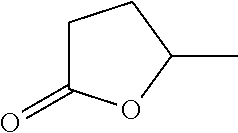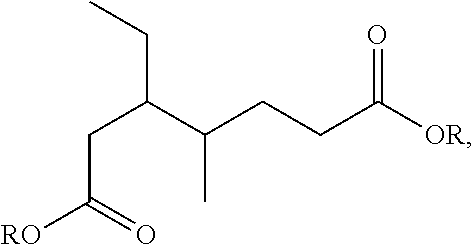Process for the hydrogenation of a lactone or of a carboxylic acid or an ester having a gamma-carbonyl group
a technology of carboxylic acid and ester, which is applied in the field of process for the hydrogenation of lactones or carboxylic acids or ester having a gamma-carbonyl group, can solve the problems of difficult opening of lactone rings, difficult to convert thus-formed -valerolactone into pentanoic acid or pentanoate,
- Summary
- Abstract
- Description
- Claims
- Application Information
AI Technical Summary
Benefits of technology
Problems solved by technology
Method used
Image
Examples
example 1
According to the Invention
Catalyst Preparation
[0057]Different catalysts, each having at least one hydrogenating metal supported on a silica-bound acidic zeolite beta, were prepared via an incipient wetness impregnation procedure. Particles (30-80 mesh) of silica bound zeolite beta (50 wt % silica and 50 wt % zeolite beta; zeolite beta with a silica / alumina ratio of 200) and a pore volume of 0.61 ml / g were impregnated with different metal solutions, dried for 2 hours at 100° C. and then calcinated for two hours at 450° C. The resultant metal concentrations (wt % metal based on the total weight of the catalyst) and the metal salt used in the impregnation solutions are shown in Table 1.
Hydrogenation Process (Experiments 1 to 5)
[0058]0.5 grams of catalyst particles were loaded in an autoclave reactor. The catalyst was reduced and dried at 15 bar hydrogen pressure and 240° C. for 30 minutes. Then 7 grams of ethyl levulinate were injected into the heated reactor and reacted under 80 bar h...
example 2
Comparison
Catalyst Preparation
[0059]Similar catalysts as described in EXAMPLE 1 were prepared with a catalyst support of silica only (no zeolite beta). The pore volume of the silica was 0.95 ml / g. The resultant metal concentrations (wt % metal based on the total weight of the catalyst) and the metal salt used in the impregnation solutions are shown in Table 1.
Hydrogenation Process (Experiments 6 to 10)
[0060]Ethyl levulinate was hydrogenated as described in EXAMPLE 1 with the catalysts comprising a hydrogenating metal on silica only (without zeolite beta). The composition of the reaction product is given in Table 1.
example 3
Hydrogenation Process (Experiments 11 to 16)
[0061]Hydrogenation experiments were carried out as described in EXAMPLE 1. As reactant, 7 grams of lactone were injected into the heated reactor. In experiments 11, 12 and 14 to 16, ethanol in an amount such that the lactone to ethanol molar ratio is 1.0 was also injected into the reactor. Different lactones were used as reactants in different experiments. In experiments 11 to 14, γ-valerolactone was used as reactant; in experiment 15, δ-hexanolactone was used as reactant; in experiment 16 (not according to the invention), gamma butyrolactone (γ-butyrolactone) was used as reactant Gamma butyrolactone is a lactone that is not substituted at the ring-closing carbon atom. The catalysts were prepared as described in EXAMPLE 1. The resultant metal concentrations (wt % metal based on the total weight of the catalyst) and the metal salt used in the impregnation solutions are shown in Table 2. In experiment 14 (not according to the invention), a ...
PUM
| Property | Measurement | Unit |
|---|---|---|
| pressure | aaaaa | aaaaa |
| temperature | aaaaa | aaaaa |
| pressures | aaaaa | aaaaa |
Abstract
Description
Claims
Application Information
 Login to View More
Login to View More - R&D
- Intellectual Property
- Life Sciences
- Materials
- Tech Scout
- Unparalleled Data Quality
- Higher Quality Content
- 60% Fewer Hallucinations
Browse by: Latest US Patents, China's latest patents, Technical Efficacy Thesaurus, Application Domain, Technology Topic, Popular Technical Reports.
© 2025 PatSnap. All rights reserved.Legal|Privacy policy|Modern Slavery Act Transparency Statement|Sitemap|About US| Contact US: help@patsnap.com



